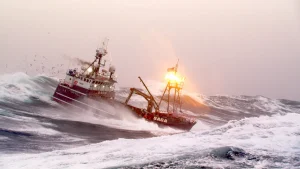The ‘Deadliest Catch’ of All? Capturing Epic Footage on Dangerous Seas
The editor and cinematographer break down how they turn 25,000 hours of footage into a compelling, cohesive story.
Article written for indiewire.com

The size and scope of producing a single season of “Deadliest Catch” is hard to fully fathom. There are seven different producing-camera teams on seven different boats, rolling cameras around the clock, producing 25,000 hours of footage over the course of a fishing season.
To ensure visual and narrative cohesion and quality, series editor Rob Butler and cinematographer David Reichert — both 2023 Emmy nominees — must stay across an enormous team and complicated workflow. It’s a task complicated by their limited ability to shape what is being shot as the stories unfold. This is because it takes weeks to get the footage off the boats (they often have to wait until the fishermen come ashore to offload their catch) and FedEx hard drives to Los Angeles, where a team of seven assistant editors load and log hundreds of hours of footage every week.
“It takes weeks and weeks before it gets in the system and I have a look at it,” said Reichert. “So what we’ve done to counteract that is we spend a solid week in Dutch Harbor with all the shooters going over how to tell the story.”
As detailed in the video below, Reichert’s preproduction camera clinics are how he lays the groundwork to establish the series’ unified look and approach coverage. According to Reichert, a vast majority of the “most hardcore” camera operators are not cut out for the challenge of shooting “Deadliest Catch.” Beyond the need to capture dynamic coverage under impossible, shooting-on-rough-seas conditions, operators are also tasked with being their own sound recordist and producer, making decisions of what stories and events are most important to track, all while fighting extreme sleep depravation, motion sickness, and the need to keep safe and their equipment dry.
Reichert, who has been with the series since Season 7, is proudest of how the cinematography has evolved and improved with each season by incorporating the latest technological advances, such as cameras that work better in low light (over half the fishing takes place at night), and testing out new camera stabilizers, drones, GoPros, and other tools that help add to the series’ ever-expanding repertoire.
What has impressed Butler is how responsive Reichert and his team are to feedback from the editorial team, as everything is in service to telling a story. That’s in part because the first step in piecing together the large interweaving narrative starts with the camera operators.
“They’ll be on the boat shooting all day and before they go to bed every night, they have to sit down and write a log of what they shot and what the big moments were,” explained Butler. It is with these notes that Butler’s editorial team starts to break the story.
“It then goes to a team of associate producers who start figuring out story threads and events that happen day-to-day,” said Butler. “They [pull together related footage] into a place where [the editors] can put that into a digestible storyline.”
It’s at this point Butler — along with fellow supervising editor Isaiah Camp, co-executive producer Johnny Beechler, and showrunner Arom Starr-Paul — start using color-coded notecards to map the various storylines over different episodes and start identifying key events that will anchor the season and keep the audience watching.





